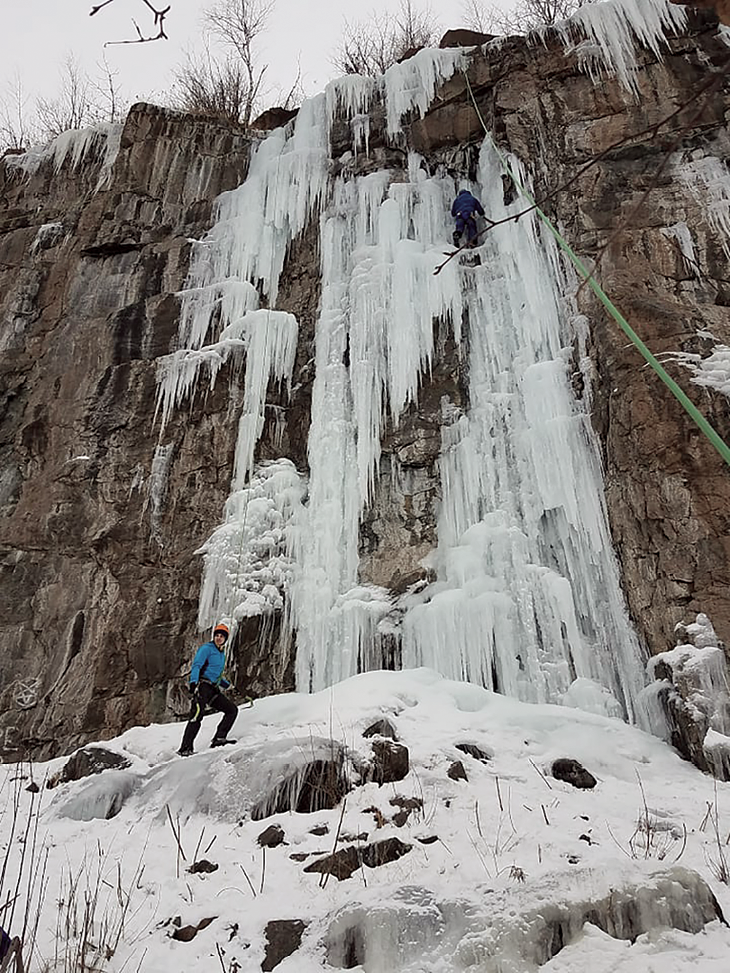How many American cities can boast a public ice-climbing park? Minnesota itself has three such “ice parks,” and Duluth’s Quarry Park has been one of them since 2016. How and why did an abandoned quarry in West Duluth become an official city park? Here’s the story of how Duluth reclaimed one of its industrial spaces and put yet another feather in its cap as an outdoor recreational paradise.
The Duluth Crushed Stone Company was responsible for creating the imposing landscape of 100-foot vertical walls of stone that give Quarry Park its name. Towering over the St. Louis River valley below, the hillside here was quarried throughout the first half of the 20th century. Rubble from the quarry was used on railroad beds, and rip rap was used for building retaining walls (like the breakwater of the Superior Entry of the Duluth-Superior Harbor). Steam drills were employed to extract the stone, which was then crushed into sizes to fit customer demand. Duluth Crushed Stone Company operated the quarry through the 1950s.
The area was then left to its own devices and local climbers started taking advantage of the amazing climbing opportunities starting in the 1970s. Locals called it “Casket Quarry:” the site neighbored Oneota Cemetery, and caskets and tombstones were made nearby. According to Eldon Krosch Jr., vice president of the Duluth Climbers Coalition, it was a completely underground place.
“People went hiking and climbing there, and had bonfires,” said Krosch Jr. “There were lots of random activities happening there. But nobody actually knew then that most of it was owned by the cemetery, and that the other part of the Quarry was privately owned by somebody who hadn’t done anything with the property. Later it was taken, forfeited to St. Louis County for unpaid taxes. People had gone in there for decades, not having any clue who owned it.”
One person who saw the site’s potential was Hansi Johnson, of the Minnesota Land Trust, who was contracted seven years ago by the city of Duluth to create a vision for investment in the city’s outdoor recreation amenities.
“I realized that Casket Quarry was a key spot, not only for the climbers, but also just for the brand of the city itself,” said Johnson. “When you’re trying to bill yourself as an adventure city, you better have some adventurous things to do. Climbing is not only adventurous, but visually it just states adventure as well.”
Johnson was able to connect city parks and rec staff with the local climbing community, and the Duluth Climbers Coalition was born out of these talks.
“I went to the climbers, who at that point were a disparate group of individuals, and pulled them together and worked with them to wrap their heads around this opportunity,” Johnson explained. Johnson also saw the community aspect as essential to the project. “The city would only work with 501(c)(3) not-for-profit organizations, and wanted to work in all cases with an organized community group that would steward whatever was going to be constructed. The Climbers Coalition raised money and awareness, including political awareness. At one point they were literally knocking on doors in the neighborhood to tell people about what was going on. You see pride in community, and public service, and stewardship.”
The city was able to purchase the quarry from St. Louis County and Oneota Cemetery and turn it into Quarry Park in May 2016, using funds from the “half and half” tourism sales tax. The once underground party spot had come full circle. The Climbers Coalition could now develop the park and one of their aims was community accessibility.
Christian Fraser, himself an ice climber, sums it up, saying “Quarry Park has a lot more to it than climbing. First and foremost, accessibility is really important here. You’re right in the west end of the city. You don’t have to travel far to get to it. It’s accessible for groups that don’t have access to personal transportation. The Climbers Coalition did a really good job promoting accessibility for all folks.”
Today you can hike, mountain bike and play frisbee golf at Quarry Park, making it a broader platform for all sorts of recreation.
For Johnson, “The coolest part about it was that when we started, much of the vision was around the idea of it being a climbing facility, but as the city went through the public process and the climbers got more involved, it was obvious that it was more than a climbing facility, it was a city park in general.”
Go take a walk at the quarry and you’ll hear the incessant trains tooting further down the hill. A 10-minute walk up the Rim Trail around the quarry walls will award you with an impressive view of the St. Louis River below. And you may get to contemplate ice climbers chipping into the frozen cliff with their ice axes and crampons, scaling West Duluth’s newest park. Or maybe you’ll join them: this adventure haven within the city makes the adrenaline-filled sport of ice climbing a public pursuit.




